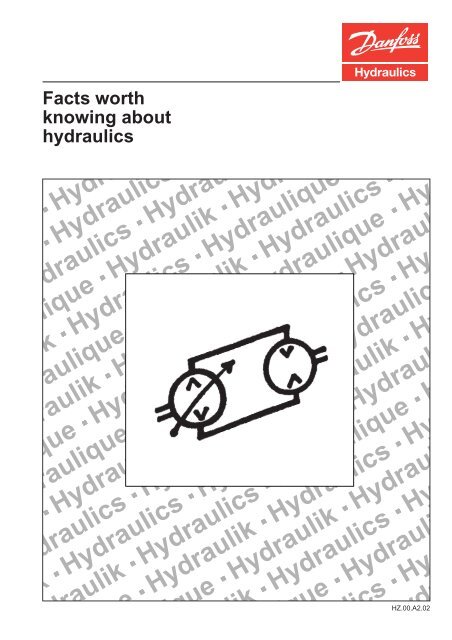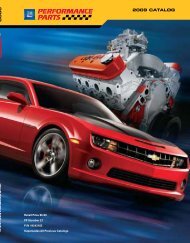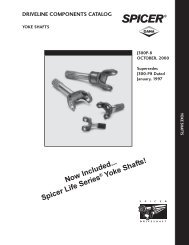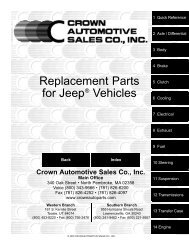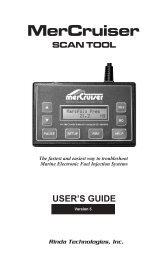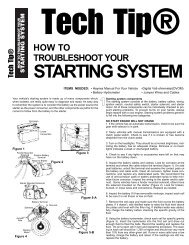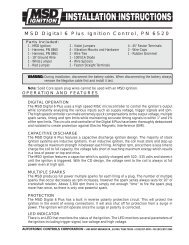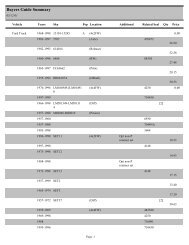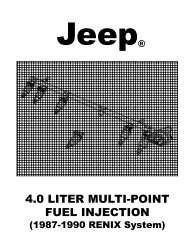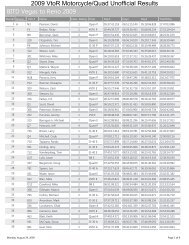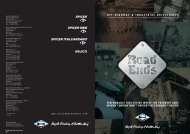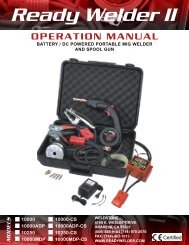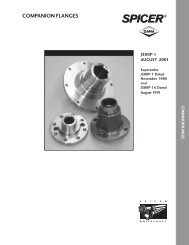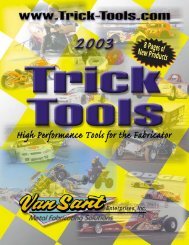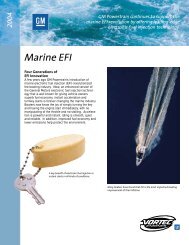Danfoss - Facts Worth Knowing About Hydraulics - WFMFiles.com
Danfoss - Facts Worth Knowing About Hydraulics - WFMFiles.com
Danfoss - Facts Worth Knowing About Hydraulics - WFMFiles.com
You also want an ePaper? Increase the reach of your titles
YUMPU automatically turns print PDFs into web optimized ePapers that Google loves.
<strong>Facts</strong> worth<br />
knowing about<br />
hydraulics<br />
■<br />
Hydra<br />
■<br />
<strong>Hydraulics</strong><br />
Hydrau<br />
Hydraulik Hydr<br />
<strong>Hydraulics</strong> Hydraulique<br />
Hydraulik <strong>Hydraulics</strong> H<br />
<strong>Hydraulics</strong> Hydraulique Hyd<br />
Hydraulik <strong>Hydraulics</strong> Hydrauli<br />
Hydraulik <strong>Hydraulics</strong> Hyd<br />
■<br />
Hydraulique Hydraulik <strong>Hydraulics</strong><br />
Hydraulique Hydraulik <strong>Hydraulics</strong> Hydraulique Hydrauli<br />
<strong>Hydraulics</strong> Hydraulique H<br />
Hydraulik <strong>Hydraulics</strong> Hyd<br />
Hydraulik Hydraul<br />
<strong>Hydraulics</strong> Hyd<br />
Hydrauli<br />
Hyd<br />
■<br />
ydraulics<br />
■ ■<br />
lique<br />
■ ■<br />
ik<br />
■ ■ ■<br />
raulique<br />
■ ■ ■<br />
raulik<br />
■ ■ ■<br />
que<br />
■ ■ ■<br />
raulique<br />
■ ■<br />
■ ■ ■<br />
draulics<br />
■ ■ ■<br />
k<br />
■ ■ ■<br />
draulik<br />
■ ■ ■<br />
e<br />
■ ■<br />
ique<br />
■ ■<br />
lik<br />
■<br />
ique<br />
■<br />
lics<br />
Hydr<br />
HZ.00.A2.02
Contents<br />
Page<br />
1. Introduction............................................................................................................. 3<br />
2. Sizing..................................................................................................................... 4<br />
3. Selection of <strong>com</strong>ponents.......................................................................................... 9<br />
4. Selection of oil type.....................................................................................................13<br />
5. Checking the oil...................................................................................................... 18<br />
6. Installation of system.............................................................................................. 18<br />
7. Starting up and running in of plant ........................................................................ 21<br />
8. Maintenance.......................................................................................................... 23<br />
9. Fault location............................................................................................................ 24<br />
10. Repair and testing ................................................................................................. 34<br />
11. Symbols and tables............................................................................................... 35<br />
12. ISO/CETOP-symbols ............................................................................................ 36<br />
13. Overview of <strong>Danfoss</strong> SERVICE SHOPS............................................................... 40<br />
2 HZ.00.A2.02
Introduction<br />
Like so many other technical fields, hydraulics<br />
is both old and new at the same time.<br />
Take waterwheels for example, people have<br />
been using them since before history was<br />
recorded. On the other hand, the use of liquid<br />
under pressure to transfer force and also to<br />
control <strong>com</strong>plicated movements is relatively<br />
new and has undergone its most rapid development<br />
within the last 40-50 years, not least<br />
because of the work that has been done in<br />
aeronautics.<br />
<strong>Hydraulics</strong> and pneumatics are universal for<br />
the entire engineering industry and are<br />
amongst the three most important media for<br />
the transference and control of force. The two<br />
other media are mechanical transference for<br />
example via clutch pedals and gears) and<br />
electrical (for example via a generator).<br />
"Flowing energy" is transferred and controlled<br />
through a medium under pressure - either air<br />
(pneumatic) or liquid (hydraulic).<br />
This form of energy has many exceptional<br />
advantages and is therefore often the most<br />
suitable form of energy transference on land,<br />
sea or in the air.<br />
A contained liquid is one of the most versatile<br />
means of controlling and transferring force. It<br />
takes the precise form of the walls that contain<br />
it and withstands its pressure. It can be divided<br />
into several streams which, depending on<br />
their size, can perform work before being<br />
allowed to merge into one stream again to<br />
perform still more work. It can be made to<br />
work fast in one part of a system and slowly in<br />
another.<br />
However, to achieve maximum utilization with<br />
highest efficiency and least possible operational<br />
stops, it is very important that a hydraulic<br />
system be designed, manufactured, started<br />
and maintained absolutely correctly. The special<br />
factors vital to the user (purchaser) must<br />
also be understood if operation in the field is<br />
not to be plagued by break downs and other<br />
disturbances.<br />
Nearly all factory systems use "flowing<br />
energy" in production. More than half of all<br />
manufactured products are based on this form<br />
of energy, and it is therefore of interest to all<br />
manufacturers, exporters, purchasers,<br />
distributors, and repairers of production<br />
systems and machines, including agricultural<br />
machines and machine tools, the village<br />
smithy and the automobile industry, shipping<br />
and aviation.<br />
Clearly, the knowledge and experience of<br />
many designers, producers, repairers and<br />
owners (users) is being outstripped by the dramatic<br />
development and rapid spread of<br />
hydraulics.<br />
The purpose of this article is therefore not to<br />
try to provide patent solutions to all hydraulic<br />
problems, but to help create an understanding<br />
of why problems arise and what steps can be<br />
taken to avoid them.<br />
No other medium <strong>com</strong>bines the same degree<br />
of reliability, accuracy and flexibility while retaining<br />
the capability of transferring maximum<br />
force with minimum volume and weight. The<br />
quality control with this medium can be <strong>com</strong>pared<br />
with the accuracy of an electronic<br />
micro-processor.<br />
HZ.00.A2.02<br />
3
Sizing<br />
Reliable sizing provides the most optimal selection<br />
of <strong>com</strong>ponents.<br />
It is obvious that if undersize <strong>com</strong>ponents are<br />
used, they will not operate under overload. They<br />
will be sensitive and be<strong>com</strong>e a frequent source<br />
of problems and <strong>com</strong>plaints. More important still,<br />
in <strong>com</strong>parison with a correctly sized <strong>com</strong>ponent<br />
an oversize <strong>com</strong>ponent will probably operate<br />
problem-free and "effortlessly" for a very long<br />
time, but its original price will be too high.<br />
If not able to carry out accurate calculations to<br />
obtain optimum conditions, the guidelines below<br />
are worth following.<br />
The first thing to establish is the max. operating<br />
pressure required for the system since this is the<br />
decisive factor in pump selection and, in turn,<br />
important as far as the size (output) of the prime<br />
mover and the system price are concerned. The<br />
higher the operation pressure, the higher the price<br />
of many of the <strong>com</strong>ponents.<br />
When the economic considerations have been<br />
made, particular types and sizes of operating<br />
cylinders, motors, and steering units to be used<br />
in the system can be considered.<br />
The pump size is found by adding the necessary<br />
amounts of oil (expressed in gallon (litres) per<br />
minute) that can be in use at the same time.<br />
Consequently, the total is the amount the pump<br />
must be able to supply at the maximum intermittent<br />
operating pressure (= pressure relief valve<br />
setting pressure).<br />
Size of pump<br />
The power applied to the pump must be found as<br />
a function of the pressure in psi (bar), revolutions<br />
per minute and flow in gal (litres) per minute,<br />
expressed in Hp (kW). The result can be used to<br />
find the size of motor that will safely yield the<br />
necessary output. See the following example.<br />
Hydraulic output N = pressure x flow, i.e.<br />
N = p x Q<br />
When calculating the necessary pump output<br />
(P nec ), account must be taken of the total pump<br />
efficiency, (η tot .) as stated in the catalogue.<br />
Example:<br />
p × Q 2175 × 11.9<br />
P an = = = 71.9 Hp<br />
400 × η t 400 × 0,9<br />
Example:<br />
p × Q<br />
N =<br />
400<br />
[ Hp ]<br />
V =<br />
Q × 1000<br />
n × η vol<br />
cm3/min-1<br />
p = 2175 psi<br />
Q = 11.9 gal/min N =<br />
2175 × 11.9<br />
= 64.71 Hp<br />
400<br />
Sizes of pipes and hoses<br />
The size depends on:<br />
- max. system pressure<br />
- max. oil flow<br />
- length of pipe system<br />
- environmental conditions<br />
Pressure drop must be as small as possible. The<br />
greater the resistance in the system, the greater<br />
the operational loss. It is important to avoid those<br />
factors which cause pressure drop, for example<br />
the use of angled screwed connections.<br />
Where possible, these should be replaced<br />
by elbows. If long lengths of pipe or high flow<br />
velocity are involved, then an increase in<br />
diameter up to the next size should be<br />
considered.<br />
Remember that the dimensions stated for the<br />
hydraulic pipes are the external diameters and<br />
wall thicknesses. The internal diameters are<br />
equal to the external diameters minus 2 x the<br />
wall thickness.<br />
Remember that when the internal diameter is<br />
doubled, the flow area of the pipe is quadrupled.<br />
Now the oil capacity supplied per minute by the<br />
pump is known, along with the amount of oil the<br />
individual <strong>com</strong>ponents must have. The next<br />
stage is the dimensioning of pipes and hoses.<br />
This is also very important as otherwise, generated<br />
cavitation (noise), heat generation, pressure<br />
drop and, in some cases, bursting can occur.<br />
There are many people who are frightened of<br />
this dimensioning as they associate it, incorrectly,<br />
with difficult mathematical calculations. In actual<br />
fact, if the nomogram adjacent is followed when<br />
calculating pipe dimensions, it is incredibly<br />
simple.<br />
In order to use the nomogram, the first thing is to<br />
know the oil flow in gallons (liters) per minute.<br />
After this it has to be known whether the pipes<br />
and hoses in question are to be used as suction<br />
lines, pressure lines or return lines. This is<br />
because there are some re<strong>com</strong>mended velocities<br />
of oil flow available for these categories. These<br />
values are as follows:<br />
- Suction line 1.6 - 4.9 ft/s<br />
- Pressure line 9.8 - 32.8 ft/s<br />
- Return line 6.6 - 16.4 ft/s<br />
4 HZ.00.A2.02
Sizing<br />
Using the nomogram<br />
Place a ruler over the two outer columns, i.e.<br />
the known oil flow and the required speed<br />
(velocity) for the pipe type in question. Read<br />
off the nearest internal pipe diameter on the<br />
middle column. (See example page 7).<br />
Depending on the maximun pressure a decision<br />
can also be made as to whether to use<br />
light or heavy hydraulic pipes and hoses. Here<br />
a large price difference is involved, especially<br />
with the associated fittings. See table of pipe<br />
dimensions and max. working pressure.<br />
Valves<br />
Valves are used in all hydraulic systems. In<br />
simple systems maybe only a pressure relief<br />
valve (safety valve) and a single directional<br />
valve are used. Other systems might be more<br />
<strong>com</strong>plicated and might involve a large number<br />
and wide variety of electronically controlled<br />
proportional valves.<br />
It is probably within valves that the choice of<br />
<strong>com</strong>ponents is widest and where it is easy to<br />
use and waste most money if wrong<br />
selections are made.<br />
If in doubt, the suppliers of recognized valve<br />
brands can be approached for advice on the<br />
selection. It is important not to select a valve<br />
which is too small or too large in relation to<br />
flow. If it is too small, the relative pressure<br />
drop will be too high, resulting in heat generation<br />
and possibly cavitation. If the valve is too<br />
large it can result in poor regulating characteristics<br />
where the cylinder will pulsate, or the<br />
system will oscillate.<br />
Calculating on tube<br />
diameter<br />
Example:<br />
Given volume = 50 l/min<br />
Given speed (velocity) = 1 m/s<br />
Found diameter = 32 mm<br />
HZ.00.A2.02<br />
5
Sizing<br />
Calculation of piston<br />
velocity - oil flow<br />
Example:<br />
Given piston velocity = 0,1 m/s<br />
Given cylinder diameter = 4.41”<br />
Found pump capacity = 47.8 gal/min<br />
6 HZ.00.A2.02
Sizing<br />
Calculation of cylinder<br />
force<br />
Example:<br />
Given pressure<br />
= 1450 bar<br />
Given cylinder diameter = 4.41”<br />
Found force<br />
= 885100 lbs in<br />
HZ.00.A2.02<br />
7
Sizing<br />
Table of cylinder power<br />
Cylinder<br />
Cylinder area<br />
Piston rod<br />
Area, piston less piston rod<br />
Push<br />
Pull<br />
250 bar 210 bar 175 bar 140 bar 100 bar 70 bar<br />
mm cm2 mm cm2 ton ton ton ton ton ton ton ton ton ton ton ton<br />
22 8,765 2,191 1,840 1,533 1,227 0,876 0,613<br />
40 12,566 3,141 2,638 2,199 1,759 1,256 0,879<br />
28 6,409 1,602 1,345 1,121 0,897 0,640 0,448<br />
28 13,478 3,369 2,830 2,358 1,886 1,347 0,943<br />
50 19,635 4,908 4,123 3,436 2,748 1,936 1,374<br />
36 9,457 2,364 1,986 1,654 1,323 0,945 0,661<br />
36 20,994 5,248 4,408 3,673 2,939 2,099 1,469<br />
63 31,172 7,793 6,546 5,455 4,364 3,117 2,182<br />
45 15,268 3,817 3,206 2,671 2,137 1,526 1,068<br />
45 34,361 8,590 7,215 6,013 4,810 3,436 2,405<br />
80 50,265 12,566 10,555 8,796 7,037 5,026 3,518<br />
56 25,635 6,158 5,173 4,311 3,448 2,463 1,724<br />
56 53,909 13,477 11,320 9,434 7,547 5,390 3,773<br />
100 78,539 19,634 16,493 13,744 10,995 7,853 5,497<br />
70 40,045 10,011 8,409 7,007 5,606 4,004 2,803<br />
70 84,233 21,058 17,689 14,741 11,793 8,423 5,896<br />
125 122,71 30,677 25,769 21,474 17,179 12,271 8,589<br />
90 59,100 14,775 12,411 10,342 8,274 5,910 4,137<br />
90 137,45 34,362 28,864 24,053 19,243 13,745 9,621<br />
160 201,06 50,265 42,222 35,185 28,148 20,106 14,074<br />
110 106,03 26,507 22,266 18,555 14,844 10,603 7,422<br />
110 219,13 54,782 46,017 38,347 30,678 21,913 15,339<br />
200 314,16 78,540 65,973 54,978 43,982 31,416 21,991<br />
140 160,22 40,055 33,646 28,138 22,430 16,022 11,215<br />
8 HZ.00.A2.02
Selection of <strong>com</strong>ponents<br />
All hydraulic systems consist in principle of the<br />
same basic <strong>com</strong>ponents, but just as with electronics,<br />
the <strong>com</strong>binations are infinite and the<br />
range of <strong>com</strong>ponents immense.<br />
Which <strong>com</strong>ponents are the most important in<br />
a system?<br />
....is it the cylinder or the motor that is going<br />
to perform the work,<br />
....or the liquid (oil) that transfers force to the<br />
motor or cylinder,<br />
... or the pipes and hoses that lead oil to<br />
motor and cylinder,<br />
....or the valves that control the oil flow paths,<br />
....or the pump that applies energy and<br />
movement to the oil,<br />
....or the motor that drives the pump,<br />
....or the filter that removes dirt from the oil,<br />
....or the oil cooler that ensures a suitable oil<br />
temperature,<br />
....or the tank that contains oil for the<br />
system..<br />
The answer must be that specific demands<br />
are made on all these <strong>com</strong>ponents and since<br />
none of them can be allowed to fail, they must<br />
all be equally important. Therefore extreme<br />
care must be taken in all stages of their creation,<br />
selection and application.<br />
When a hydraulic diagram is being prepared,<br />
the designer must have quality in mind, including<br />
the quality of the drawing itself, so that any<br />
errors in interpreting the drawing are avoided.<br />
It is a good idea always to use the correct<br />
ISO/CETOP-symbols.<br />
When the diagram is subsequently used in<br />
preparing parts lists and accurate <strong>com</strong>ponent<br />
specifications, sizing problems often occur.<br />
The designer is confronted with brightly coloured<br />
brochures and catalogues and, at first,<br />
all is confusion. The temptation is to revert to<br />
rule-of-thumb methods and "add a bit for<br />
safety's sake", the result being a system which<br />
is either over or under designed.<br />
All reputable hydraulic <strong>com</strong>ponent manufacturers<br />
give real, usable values in their catalogues,<br />
not just theoretical desired values. The<br />
technical data in <strong>Danfoss</strong> catalogues always<br />
represents average values measured from a<br />
certain number of standard <strong>com</strong>ponents. In<br />
addition to these data, the catalogues contain<br />
a mass of useful and explanatory information<br />
on selection, installation and start up of <strong>com</strong>ponents,<br />
together with a description of their<br />
functions. This information must, of course, be<br />
used as intended in order to avoid overload,<br />
too high a wear rate, and consequent oil overheating<br />
and to avoid an over-dimensioned<br />
system with poor regulation at too high a price.<br />
The tank<br />
Let us look a little closer at an example<br />
system, starting with:<br />
The tank, which has many functions e.g.<br />
- as a reservoir for the system oil<br />
- as a cooler<br />
- as a "coarse strainer", sedimentation of<br />
impurities<br />
- as an air and water separator<br />
- as a foundation for pumps etc.<br />
The dimensions of the tank and its form are<br />
important and it should therefore be designed<br />
for its purpose, the same as all other hydraulic<br />
<strong>com</strong>ponents. Its location must also be taken into<br />
account so that the sight glass, filters, filling cap,<br />
air filter, drain cock, etc. are easily accessible for<br />
daily inspection. If the application is mobile, if<br />
there is no cooler built into the system, and provided<br />
the tank is located where air circulation is<br />
good, the size of the tank can be fixed at<br />
approx. 3-4 times the capacity of the pump per<br />
minute.<br />
Two arrangements are shown below.<br />
Arrangement 1 is preferred as this increases the<br />
cooling effect as much as possible.<br />
Arrangement 1 Arrangement 2<br />
HZ.00.A2.02<br />
9
Selection of <strong>com</strong>ponents<br />
To increase the ability of the tank to separate<br />
dirt and water, the bottom must be slightly<br />
inclined (deepest end opposite the inlet/outlet<br />
end). An ordinary cock (without handle) is fitted<br />
so that impurities can easily be drained off.<br />
Increased separation of the air that is always<br />
present in the oil can be obtained by fitting an<br />
inclined coarse metal strainer (approx. 25-50<br />
mesh/ inch) by the return line.<br />
Both suction and return pipes must be cut diagonally.<br />
The ends of the pipes must be<br />
located 2-4 times the pipe diameter above the<br />
bottom of the tank, partly to avoid foaming at<br />
the return line, and partly to prevent air from<br />
being drawn into the suction line, especially<br />
when the vehicle/vessel heels over to one<br />
side. With regard to the annual "spring-clean",<br />
the tank must have large removable covers,<br />
either in the sides, in the top, or in the ends, in<br />
order to give easy access for cleaning. If filters<br />
are installed, they must be located above the<br />
tank oil level and must be easy to replace<br />
without significant spillage. That is to say, it<br />
must be possible to place a drip tray under the<br />
filter inserts.<br />
Since tanks are made of steel plate, rust is<br />
inevitable (even below the oil level, because<br />
oil contains both water and oxygen) and it is<br />
therefore advisable to surface-treat the inside.<br />
If the tank is to be painted, thorough cleaning<br />
and degreasing is necessary before primer<br />
and top coats are applied. The paint used<br />
must, of course, be resistant to hot hydraulic<br />
oil.<br />
If the cooling effect from the tank and other<br />
hydraulic <strong>com</strong>ponents is insufficient in order to<br />
keep oil temperature down to an acceptable<br />
maximum an oil cooler must be fitted. Most<br />
suppliers prescribe 194 °F (90°C) as an absolute<br />
max-imum partly because of lifetime of<br />
rubber parts, partly because of alterations of<br />
tolerances and possibly bad lubrication. Today<br />
quite often electronic devices are fitted directly<br />
onto the hot hydraulic <strong>com</strong>ponents. In consideration<br />
of the electronics, a reduction of the<br />
max. oil temper-ature to under 176 °F (80°C)<br />
must be aimed at.<br />
Filters<br />
The degree of filtering and filter size are based<br />
on many different criteria that generalisation is<br />
seldom possible. The most important factors<br />
to be considered are as follows:<br />
Operational environment:<br />
How serious would the consequences be if the<br />
system failed because of dirt?<br />
Oil quantity:<br />
Would there be a few litres or several hundred<br />
litres in the system? Is it an expensive or a<br />
cheap oil?<br />
Operational down time:<br />
What would it cost per hour/day if the system<br />
shut down? How important is this factor?<br />
Dirt sensitivity:<br />
How dirt-sensitive are the <strong>com</strong>ponents? What<br />
degree of filtering is re<strong>com</strong>mended by the<br />
<strong>com</strong>ponent manufacturers?<br />
Filter types:<br />
Are suction filters, pressure filters or return filters<br />
to be used, or a <strong>com</strong>bination of these with<br />
or without magnets? Is exclusive full-flow filtering<br />
involved, or will there also be by-pass filtering<br />
through fine filters? Which type of dirt<br />
indicators are to be used, visual, mechanical<br />
or electrical?<br />
Air filtration:<br />
Air must be filtered to the same degree as the<br />
finest filter in the system, otherwise too much<br />
dirt can enter the tank with the air. If there is a<br />
large differential or plunger cylinders are in the<br />
system, the tank breathes in/pushes out large<br />
amounts of air, therefore the size of the air filter<br />
must be on the large side. Remember that<br />
dirt particles visible to the naked eye (larger<br />
than 40 µm) are as a rule, less dangerous<br />
than those that cannot be seen. It is often the<br />
hard particles of 5 - 25 µm, corresponding to<br />
normal hydraulic <strong>com</strong>ponent tolerances, that<br />
are the most dangerous.<br />
10 HZ.00.A2.02
Selection of <strong>com</strong>ponents<br />
Relative size of<br />
particles<br />
25 µm, (e.g. white blood corpuscles)<br />
8 µm, (e.g. red blood corpuscles)<br />
5 µm<br />
2 µm, (e.g. bacteria)<br />
The naked eye is unable to see objects smaller<br />
than 40 µm.<br />
For normal operation, the degree of filtration<br />
for hydraulic products can generally be divided<br />
into the categories below:<br />
Motors:<br />
25,um nominal - degree of contamination<br />
20/16 (see ISO 4406) for return filter, or <strong>com</strong>bined<br />
with a magnetic insert if a coarser filter<br />
is used, e.g. 40 µm.<br />
Steering units:<br />
For systems having an efficient air filter and<br />
operating in clean surroundings, 25 µm nominal<br />
is adequate. If this is not the case 10 µm<br />
absolute - to 19/16 must be fitted. Filters can<br />
be either pressure or return filters.<br />
Proportional valves:<br />
System filters<br />
Where demands for safety and reliability are<br />
very high a pressure filter with bypass and<br />
indicator is re<strong>com</strong>mended. Experience shows<br />
that a 10 µm nominal filter (or finer) or a 20 µm<br />
absolute filter (or finer) is suitable.<br />
It is our experience that a return filter is<br />
adequate in a purely mechanically operated<br />
valve system.<br />
Radial piston pumps:<br />
In open as well as closed systems:<br />
Suction filter:<br />
100 µm nominal or finer, but not finer than 40<br />
µm nominal.<br />
Return filter:<br />
20 µm absolute or 10 µm nominal - 19/16.<br />
Filters should be fitted with a dirt indicator so<br />
that operating conditions can be observed.<br />
This is especially important with suction filters<br />
to avoid pressure drop in the suction line and<br />
consequent cavitation. The pressure in the<br />
suction line must not be less than 11.6 psi (0.8<br />
bar) absolute.<br />
Remember that drain lines from valves,<br />
motors etc. must also be led through the<br />
return filter to the tank. For pumps the drain oil<br />
pressure must not exceed 14.5 psi (1 bar).<br />
Therefore the drain oil should bypass the filters.<br />
The fineness of a pressure filter must be selected<br />
as discribed by the filter manufacturer so<br />
that a particle level 19/16 is not exceeded.<br />
HZ.00.A2.02<br />
11
Selection of <strong>com</strong>ponents<br />
Dimensions<br />
Remember that drain lines from valves,<br />
motors etc. must also be routed through the<br />
return filter to the tank. For pumps, the drain<br />
oil pressure must not exceed 14.5 psi (1 bar),<br />
therefore the drain oil should bypass the fil-<br />
table salt<br />
industrial smog<br />
human hair<br />
visible particles<br />
pollen<br />
fog<br />
withe blood corpuscles<br />
invisible particles<br />
talcum powder<br />
red blood corpuscles<br />
bacteria<br />
12 HZ.00.A2.02
Selection of oil type<br />
Oil requirements<br />
The oil in a hydraulic system must first and<br />
foremost transfer energy, but the moving parts<br />
in <strong>com</strong>ponents must also be lubricated to<br />
reduce friction and consequent heat generation.<br />
Additionally, the oil must lead dirt particles<br />
and friction heat away from the system and<br />
protect against corrosion.<br />
- good lubricating properties<br />
- good wear properties<br />
- suitable viscosity<br />
- good corrosion inhibitor<br />
- good anti-aeration properties<br />
- reliable air separation<br />
- good water separation<br />
Types of hydraulic fluids<br />
- Mineral oil<br />
- Water<br />
- Oil/water-emulsions<br />
- Water/polyglycol mixture<br />
- Synthetic liquids<br />
Oil types<br />
The most <strong>com</strong>mon hydraulic oil is a mineral<br />
based oil.<br />
CETOP RP75H-class is <strong>com</strong>prised of the<br />
following 4 groups:<br />
- HH: oil without additives - HL: oil with special<br />
additives for improving fluid life-durability and<br />
protecting against corrosion - HM: "HL" + additives<br />
for improving wear-properties - HV:<br />
"HM" + additives for improving the viscosity<br />
index<br />
However, it can be an advantage to use other<br />
types of oils, especially in mobile systems<br />
such as tractors, etc. There is an advantage to<br />
be gained here from the use of the same oil<br />
for the diesel motor, the gearbox and the<br />
hydraulic system which often supply oil to both<br />
the working hydraulics and the steering. Other<br />
systems use transmission oil for the gearbox<br />
and hydraulics. In mines and off-shore installations,<br />
fire retarding liquids are used.<br />
Non-inflammable fluids<br />
Fire retarding hydraulic oils are sometimes<br />
classified as "non-inflammable hydraulic oils",<br />
but they will all burn under unfavourable<br />
conditions.<br />
In water-based hydraulic oils it is solely the<br />
water that makes them fire retarding. When<br />
the water has evaporated, they can burn.<br />
Among synthetic fire retarding hydraulic oils,<br />
only phosphate esters are used.<br />
It is important to select an oil type containing<br />
the correct additives, i.e. those which match<br />
the problem-free operation and long operating<br />
life for both hydraulic <strong>com</strong>ponents and the oil<br />
itself can be ensured by following the maintenance<br />
instructions.<br />
Additives<br />
To improve the characteristics of a mineral oil,<br />
different kinds of additives are used. Normally<br />
the desire is to improve the following characteristics:<br />
- Lubrication with metal/metal contact at high<br />
and low speeds.<br />
- Viscosity change must remain small in a<br />
wide temperature and pressure range. This<br />
characteristic is called the viscosity index<br />
(Vl)<br />
- Air solubility must be low and air emission<br />
high.<br />
- Foaming tendency must be low.<br />
- Rust protection must be high.<br />
- The toxicity of the oil and its' vapour must be<br />
low.<br />
The amount and type of these additives are<br />
seldom given by suppliers, for such precise<br />
data are hardly of significance. The exception<br />
however, is antiwear additives because these<br />
are important as far as avoiding seizing and<br />
prolonging the operating life of the system.<br />
In the opinion of <strong>Danfoss</strong>, the ideal oil<br />
contains:<br />
either : 1.0-1.4% Dialkylzincdithiophosphate<br />
(tradename Lubrizol 677A)<br />
or<br />
or<br />
: 1.0-1.6% tricresylphosphate<br />
(tradename Lindol oil)<br />
: 1.0-1.6% Triarylphosphate<br />
(tradename Coalite)<br />
or<br />
: additives producing similar effects.<br />
HZ.00.A2.02<br />
13
Selection of oil type<br />
Motor oil<br />
Motor oils and most transmission oils contain<br />
self-cleaning additives. These are a disadvantage<br />
in hydraulic systems.<br />
For example, water condensed from the oil<br />
cannot be drained off; it forms an emulsion<br />
with the oil. This in turn leads to filters be<strong>com</strong>ing<br />
clogged too quickly.<br />
Viscosity<br />
classification system<br />
The International Organisation for Standardisation<br />
(ISO) has developed a system<br />
viscosity classification system for industrial<br />
lubricating oil which Shell and the other large<br />
oil <strong>com</strong>panies have decided to introduce<br />
(ISO 3448)<br />
Viscosity diagram<br />
ISO Middle viscosity Kinematic Viscosity limits in cSt (mm 2 /s)<br />
Viscosity No. in cSt (mm 2 /s) at 104°F at 104°F (40°C)<br />
40°C Minimum Maximum<br />
ISO VG 2,00 2,20 1,98 2,42<br />
ISO VG 3,00 3,20 2,88 3,52<br />
ISO VG 5,00 4,60 4,14 5,06<br />
ISO VG 7,00 6,80 6,12 7,48<br />
ISO VG 10,00 10,00 9,00 11,00<br />
ISO VG 15,00 15,00 13,50 16,50<br />
ISO VG 22,00 22,00 19,80 24,20<br />
ISO VG 32,00 32,00 28,80 35,20<br />
ISO VG 46,00 46,00 41,40 50,60<br />
ISO VG 68,00 68,00 61,20 74,80<br />
ISO VG 100,00 100,00 90,00 110,00<br />
ISO VG 150,00 150,00 135,00 165,00<br />
ISO VG 220,00 220,00 198,00 242,00<br />
ISO VG 320,00 320,00 288,00 352,00<br />
ISO VG 460,00 460,00 414,00 506,00<br />
ISO VG 680,00 680,00 612,00 748,00<br />
ISO VG 1000,00 1000,00 900,00 1100,00<br />
ISO VG 1500,00 1500,00 1350,00 1650,00<br />
14 HZ.00.A2.02
Checking the oil<br />
Water in the oil<br />
There is evidence that more than 70% of all<br />
problems with hydraulic systems can be<br />
traced directly to the condition of the oil.<br />
If there is water in the oil, the oil must be replaced<br />
as this not only damages the ball and<br />
roller bearings but also causes corrosion of all<br />
steel surfaces. This especially applies to those<br />
surfaces touched by the oil, for in addition to<br />
water, oxygen is present and this promotes<br />
rust. A further danger is the reduction of the<br />
operative area of filters and the consequent<br />
increase in the abrasiveness of the oil.<br />
Oil oxidation<br />
Normally an oil operating temperature of 86°F-<br />
140°F (30-60°C) ought to be aimed at since<br />
the life of hydraulic oil is strongly dependent<br />
on its op-erating temperature. The rule-ofthumb<br />
is that the useful life of an oil is halved<br />
for every 46.4°F (8°C) the temperature rises<br />
above 140°F (60°C). That is to say, at 194°F<br />
(90°C) the life of the oil is only about 10% of<br />
its life at 140°F (60°C).<br />
The reason for this is oxidation. At atmospheric<br />
pressure, all oils contain a little less<br />
than 0.03 gal (0.1 Iitres) of air per 0.264 gal<br />
(litre) of oil. Therefore, in practice, oxygen is<br />
always present and it reacts with the hydrocarbons<br />
making up the oil. Gradually, as oxidation<br />
increases, the oil be<strong>com</strong>es darker in colour<br />
and its' viscosity rises.<br />
Finally, the products of oxidation can no longer<br />
be dissolved in the oil, but instead settle everywhere<br />
in the system as a brown sticky layer.<br />
This will cause sticking valves and high friction<br />
in ball bearings, valve spools and pump<br />
pistons. Oxidation also produces<br />
corrosive acids.<br />
The oxidation process begins gradually, but at<br />
a certain stage the oxidation rate suddenly<br />
rises and the viscosity rises. The resulting<br />
increase in operating temperature accelerates<br />
the oxidation process even more and soon the<br />
oil be<strong>com</strong>es quite unusable as a hydraulic oil<br />
because of deposits, high viscosity and accumulated<br />
acids. It therefore pays to take care of<br />
the oil. Even without proper laboratory equipment,<br />
many factors can be checked.<br />
The presence of water<br />
It is possible to make the following checks:<br />
The presence of water can be detected as follows.<br />
Drain 32.8 or 49.2 in 3 (cm 3) of oil into a<br />
test tube and allow it to stand for a few minutes<br />
until any air bubbles have disappeared.<br />
Then heat up the oil, with a gas lighter, for<br />
example, and at the same time listen (at the<br />
top of the test tube) for small "explosions" in<br />
the oil. This sound <strong>com</strong>es from the creation of<br />
water vapour when the small water particles in<br />
the oil are shock-boiled.<br />
Viscosity<br />
Viscosity can be established with sufficient<br />
accuracy using homemade equipment consisting<br />
of a small container (e.g. a can) which is<br />
able to hold 0.2 gal ( 3 ⁄ 4 liters) of liquid. The bottom<br />
of the can must be pushed slightly<br />
outwards and a burr-free hole of 0.16”-0.2”<br />
(4-5 mm) drilled. Pour water which has been<br />
heated to 104°F-122°F (40 - 50°C) into the<br />
can whilst keeping a finger over the hole.<br />
Remove the finger and record in seconds how<br />
long it takes for the water to run out. Repeat<br />
the process, but this time use oil. The viscosity<br />
of the oil can be calculated in degrees Engler<br />
(E°).<br />
Engler Viscosity =<br />
drain time for oil<br />
= E°<br />
drain time for water<br />
See conversion table page 20.<br />
HZ.00.A2.02<br />
15
Checking the oil<br />
The smell and appearance<br />
The smell and appearance of an oil sample<br />
also reveals much about its condition, especially<br />
if it is <strong>com</strong>pared with a sample of clean<br />
unused oil at the same temperature and in the<br />
same kind of glass container. By allowing two<br />
such samples to stand overnight, the bottom<br />
of the glass containing the used oil might<br />
reveal a deposit. If it does the oil in the system<br />
must be fine-filtered and the tank cleaned.<br />
If these relatively crude tests indicate that the<br />
oil might be bad, small systems should scrap<br />
the oil. For larger systems an oil sample of<br />
approx. 1 ⁄ 2 - 1 liter should be sent to a laboratory<br />
for a thorough check. Remember it is<br />
important that the bottles used for the samples<br />
are <strong>com</strong>pletely clean.<br />
Tables for converting<br />
viscosity<br />
cSt E° R S cSt E° R S<br />
1,00 1,00 26,7 29,3 26,00 3,58 109,1 123,6<br />
1,50 1,07 28,4 31,3 27,00 3,71 113,0 128,0<br />
2,00 1,12 30,3 33,1 28,00 3,83 117,0 132,4<br />
2,50 1,17 31,7 34,8 29,00 3,96 120,9 136,8<br />
3,00 1,22 33,0 36,5 30,00 4,09 124,8 141,3<br />
3,50 1,27 34,5 38,0 31,00 4,21 128,8 145,7<br />
4,00 1,31 35,8 39,5 32,00 4,34 132,7 150,2<br />
4,50 1,35 37,1 41,0 33,00 4,47 136,6 154,7<br />
5,00 1,40 38,5 42,5 34,00 4,58 140,6 159,2<br />
5,50 1,44 39,7 44,0 35,00 4,71 144,4 163,7<br />
6,00 1,48 41,1 45,4 36,00 4,83 148,8 168,2<br />
6,50 1,52 42,4 47,0 37,00 4,96 152,5 172,8<br />
7,00 1,57 43,8 48,6 38,00 5,09 156,5 177,3<br />
7,50 1,60 45,2 50,2 39,00 5,22 160,5 181,9<br />
8,00 1,65 46,5 51,8 40,00 5,34 164,5 186,5<br />
8,50 1,70 48,0 53,4 41,00 5,47 168,6 191,0<br />
9,00 1,75 49,4 55,1 42,00 5,60 172,6 195,6<br />
9,50 1,79 51,0 56,8 43,00 5,73 176,6 200,2<br />
10,00 1,83 52,4 58,5 44,00 5,86 180,7 204,8<br />
10,50 1,88 53,9 60,2 45,00 5,99 184,7 209,4<br />
11,00 1,93 55,4 62,0 46,00 6,11 188,7 214,1<br />
12,00 2,02 58,5 65,6 47,00 6,25 192,8 218,7<br />
13,00 2,12 61,8 69,3 48,00 6,37 196,8 223,3<br />
14,00 2,22 65,1 73,1 49,00 6,50 200,8 227,9<br />
15,00 2,32 68,4 77,0 50,00 6,63 204,8 232,6<br />
16,00 2,43 71,8 81,0 51,00 6,76 208,9 237,2<br />
17,00 2,54 75,4 85,0 52,00 6,88 213,1 241,8<br />
18,00 2,65 79,0 89,2 53,00 7,01 217,2 246,5<br />
19,00 2,76 82,8 93,4 54,00 7,15 221,3 251,1<br />
20,00 2,88 86,7 97,6 55,00 7,27 225,3 255,7<br />
21,00 2,99 90,4 101,9 56,00 7,40 229,4 260,4<br />
22,00 3,10 94,0 106,2 57,00 7,53 233,4 365,0<br />
23,00 3,22 97,8 110,5 58,00 7,67 237,4 269,6<br />
24,00 3,35 101,5 114,9 59,00 7,79 241,4 27,.2<br />
25,00 3,46 105,2 119,2 60,00 7,92 245,5 278,0<br />
cSt = Centistoke (mm 2 /s)<br />
E° = Engler°<br />
R<br />
S<br />
= Redwood<br />
= Saybolt<br />
16 HZ.00.A2.02
Checking the oil<br />
Hydraulic oil life conditi<br />
in % based on temperatur<br />
conditions<br />
Lifetime in<br />
Oil temperature (return side of tank)<br />
Increased noise<br />
Max. re<strong>com</strong>mended operating temperature<br />
(reduced life)<br />
Max. operating temperature with optimal oil life<br />
Appreciable noise increase<br />
Optimal operating temperatur<br />
Lowest start temperatur<br />
HZ.00.A2.02<br />
17
Installation of system<br />
After the designer has made calculations and<br />
selected the correct <strong>com</strong>ponents, a number of<br />
questions have to be considered:<br />
Where and how are the <strong>com</strong>ponents to be<br />
placed?<br />
This must be in strict accordance with,<br />
amongst others, the following factors:<br />
- Suitability in relation to the work the motor or<br />
cylinder must perform.<br />
- Easily accessible for installation and inspection,<br />
and not least for repair or replacement.<br />
There is no such thing as a system that<br />
never needs to be repaired.<br />
- Maximum heat emission is obtained by<br />
locating individual <strong>com</strong>ponents, tanks, pipes,<br />
hoses and filters at the outer boundaries of<br />
the system. If pipes are bracketed to the<br />
machine frame or vehicle chassis, large<br />
amounts of heat will be given off.<br />
Remember to follow catalogue instructions on<br />
pipes, hoses and fittings.<br />
Remember that pipes which are welded or<br />
hot-bent must be thoroughly cleaned. Scale<br />
etc. must be cleaned by wire brushing or by<br />
pickling followed by thorough flushing and<br />
drying.<br />
Remember it is very advisable to read the<br />
supplier's directions and meet the requirements<br />
contained in the installation instructions<br />
which nearly always ac<strong>com</strong>pany <strong>com</strong>ponents.<br />
Remember the three most important rules to<br />
be followed when working with hydraulics<br />
are:<br />
1. CLEANLINESS<br />
2. CLEANLINESS<br />
3. CLEANLINESS<br />
- Noise suppression is the subject of environ<br />
ment legislation and much can be achieved<br />
by installing pumps and their motors on<br />
dampers and by using hoses between all<br />
moving/vibrating <strong>com</strong>ponents and rigid<br />
parts.<br />
Rule 1<br />
Concerns cleanliness during the installation of<br />
the hydraulic system.<br />
Hoses, pipes and fittings are never clean after<br />
being worked on and must therefore always<br />
be cleaned immediately prior to installation.<br />
Pipes, including pipe bends, should preferably<br />
be cleaned with a plug of crepe paper or<br />
lint-free cloth soaked in paraffin and blown<br />
through the pipe with <strong>com</strong>pressed air. This<br />
process must be repeated with several plugs<br />
until a <strong>com</strong>pletely clean plug emerges. If pipes<br />
have been hot-bent or welded they must be<br />
cleaned by pickling in hydrochloric acid, flushed<br />
with cold and then hot water and dried.<br />
If the pipes are not to be fitted immediately,<br />
they must be lubricated with clean hydraulic<br />
oil and plugged, otherwise they will rust. The<br />
blanking plugs fitted in all pumps, motors, valves,<br />
etc. must not be re-moved until just before<br />
the <strong>com</strong>ponents are installed.<br />
Workshops, work stations, tools and clothing<br />
must also be as clean as possible. Then there<br />
is smoking! Apart from the fire risk, tobacco<br />
ash is harmful, it acts as an abrasive. Smoking<br />
should therefore be prohibited.<br />
18 HZ.00.A2.02
Installation of system<br />
Fine filtration of the oil via a filling filter unit is<br />
strongly re<strong>com</strong>mended. When filling from<br />
drums there are nearly always too many particles<br />
in the oil, especially in the bottom where<br />
there is often a little water too. An example of<br />
a portable filling filter unit is shown below. It<br />
consists of a 3 ⁄ 4 hk single phase electric motor<br />
driving a low pressure pump of 15-20 I/min<br />
capacity. The pump sucks from the oil drum<br />
through a pipe that can be screwed into the<br />
3 ⁄ 4 BSP drum connector. The diagonally cut<br />
end of the pipe extends to approx. 4-5 cm<br />
above the bottom. Oil is sucked through a<br />
40 µm coarse strainer with magnetic insert<br />
and then through a 5 µm fine filter. The fine<br />
filter can be equipped with a low pressure<br />
switch that stops the pump when the filter is<br />
about to be<strong>com</strong>e saturated with dirt particles.<br />
Oil<br />
HZ.00.A2.02<br />
19
Installation of system<br />
Rule 2<br />
Rule 3<br />
Concerns cleanliness during daily operation of<br />
a hydraulic system.<br />
Here, the main objective is to prevent the oil<br />
from be<strong>com</strong>ing dirty. That is to say, filters<br />
(including air filters) must be clean - especially<br />
piston rods, shafts and shaft seals. It has been<br />
proven that on every square centimetre of<br />
piston rod area, one dirt particle of more than<br />
10µm penetrates the cylinder. Imagine a<br />
piston rod of ø 50 mm, a length of just 100<br />
mm, and a velocity of 12 m/min. This means<br />
about 20.000 particles larger than 10 µm per<br />
minute!<br />
The tools used for filling must of course be<br />
perfectly clean and the oil filled into the<br />
Concerns cleanliness during inspection and<br />
repair.<br />
Here also it goes without saying that everything<br />
should be kept as clean as pos-sible.<br />
Before a hydraulic <strong>com</strong>ponent is<br />
removed, both the <strong>com</strong>ponent itself and the<br />
immediate surroundings must be clean.<br />
All loose paint scale must be removed before<br />
screwed connections are dismantled and all<br />
open parts, pipes, hoses, etc. must be<br />
blanked off with, for example, plastic bags<br />
system must be filtered through filters of the<br />
same fineness as the finest in the system, normally<br />
5 µm, but in any event no coarser than<br />
10 µm nominal. Oil in large drums is not normally<br />
clean enough and, depending on the<br />
storage, often contains water. Therefore<br />
drums should be laid down during storage, or<br />
better still, should stand on a slant if kept outdoors<br />
so that water cannot collect around the<br />
plugs.<br />
bound on so that dirt and dust cannot enter<br />
the system when it is in standstill.<br />
A hydraulic <strong>com</strong>ponent must never be dismantled<br />
outdoors, but always in a closed<br />
workshop equipped with necessary facilities,<br />
special equipment and trained personnel.<br />
20 HZ.00.A2.02
Starting up and running in of plant<br />
Correct starting up and running-in is of the<br />
utmost importance in ensuring that the system<br />
runs for a long time without problems. All to<br />
often, many systems and especially pumps<br />
"die" after only a few hours running, some<br />
after only a few minutes, because the most<br />
elementary steps have been overlooked. One<br />
example is the non-observance of the cleanliness<br />
rules before and during start-up.<br />
But despite even the best degree of cleanliness<br />
and care during installation, the presence<br />
of dirt in a new system cannot be<br />
avoided. During running-in, wear particles will<br />
be produced from all moving parts. It is therefore<br />
important not to apply full load to the<br />
system before this dirt has been filtered out.<br />
Let us look at our system which is fitted with a<br />
<strong>Danfoss</strong> pump type VPA and study the procedure<br />
for starting up:<br />
1. Examine the tank to make sure it is perfectly<br />
clean internally. If it is not, clean it out<br />
with a vacuum cleaner. Often during instalation,<br />
it is necessary to bore and tap a<br />
few extra holes which are not shown on the<br />
rawing.<br />
2. Fill with clean oil of the correct type -<br />
through a filtering unit as described on<br />
page 23. If such a unit is not available, any<br />
filling funnels, cans, hoses must be<br />
thoroughly cleaned before they are used.<br />
Oil is filled through the return filter.<br />
3. Before the pump is started, check the<br />
following:<br />
a) Have all the flanges and screwed<br />
connections been tightened? (There is<br />
always one that hasn't).<br />
b) Is the directional valve in its neutral<br />
position? (If it is not, the results can be<br />
catastrophic).<br />
c) Is the pressure relief valve set at minimum?<br />
(The result of a leak or a malfunction<br />
is more violent at high pressure than<br />
at low pressure).<br />
d) Does the pump rotate in the correct<br />
direction? (Nearly all pumps have a particular<br />
direction of rotation: clockwise or<br />
counterclockwise looking on the end of<br />
the output shaft. The direction ought to be<br />
clearly marked with an arrow. Many<br />
pumps will not withstand being rotated in<br />
the wrong direction for more than a few<br />
minutes).<br />
e) Is the pump and any suction line filled<br />
with oil? (Some pumps cannot withstand<br />
being rotated for more than a few minutes<br />
without oil in the pump housing).<br />
4. Connect a vacuum meter in the suction line,<br />
as close to the pump as possible. Connect<br />
a 250 bar pressure gauge to the high pressure<br />
side of the system. Connect a 5 bar<br />
pressure gauge to the upper drain connection.<br />
Pumps with a priming pump must be fitted<br />
with a 25 bar pressure gauge on the priming<br />
pump take-off. If there is more than<br />
one pump on the same shaft, each pump<br />
must be fitted with these pressure gauges.<br />
5. If possible, connect the discharge side of<br />
the pump to the tank, otherwise to a 5-10<br />
litre container.<br />
6. Set the pump displacement to at least 40%<br />
of maximum.<br />
7. Start the pump (with a <strong>com</strong>bustion engine<br />
at 800-900 r/min, or with an electric motor<br />
having short-duration start/stop functions).<br />
When the pump starts to suck (oil runs into<br />
the tank or container) stop the pump and<br />
connect its pressure outlet to the high pressure<br />
side of the system.<br />
8. If the pump does not suck relatively quickly,<br />
check the following:<br />
a) Is the suction line leaky?<br />
b) Is there free flow in the suction line?<br />
c) Does the pump rotate at all?<br />
d) Is the pump set for min. 40%<br />
displacement?<br />
9. Start the pump once more. Operate each<br />
directional valve for each motor or cylinder<br />
one after another, with a necessary bleeding<br />
at as low a pressure as possible.<br />
Repeat until the return oil in the tank does<br />
not foam and the motors and cylinders<br />
operate smoothly. Check the oil level<br />
frequently and refill with filtered oil.<br />
10. A further frequent check: make sure that<br />
the suction pressure is at least 0.8 bar<br />
absolute, corresponding to 0.2 bar on the<br />
scale. After a short time, the drain pressure<br />
must be max. 1 bar.<br />
11. Set the pump for max. displacement and<br />
the motor for max. speed (but not higher<br />
than 3150 r/min continuous) and allow the<br />
system to run unloaded for about 20 minutes,<br />
until the oil temperature has stabili<br />
zed. Reverse the direction of the motor and<br />
the travel of the cylinders frequently.<br />
12. Set the individual pressure relief valves<br />
and the pump pressure control valve at the<br />
specified pressure. Any schock valves in<br />
the system must be set at approx. 30-40<br />
bar over the constant operating pressure.<br />
Check the oil temperature.<br />
13. If required, the pump max. oil flow can be<br />
set using the flow limiter.<br />
HZ.00.A2.02<br />
21
Starting up and running in of plant<br />
14. Remove the pressure gauges and vacuum<br />
meter and insert plugs in the connections.<br />
Replace filter inserts with new ones.<br />
Check the oil level.<br />
15. If there is a large amount of oil (e.g. more<br />
than 100 litres in the system), an oil<br />
sample can be taken and sent to the oil<br />
supply firm for analysis.<br />
16. The system can now be put to work.<br />
22 HZ.00.A2.02
Maintenance<br />
Nearly all hydraulic systems, stationary as well<br />
as mobile, are ac<strong>com</strong>panied by operating<br />
instructions, but the issue of maintenance<br />
instructions is just as important. To be able to<br />
correctly maintain a hydraulic system, the<br />
customer (end user) must know what has to<br />
be done. The transfer of this knowledge is the<br />
responsibility of the manufacturer.<br />
Periodic inspection<br />
The regular inspection of a hydraulic system is<br />
more economical than making repairs when a<br />
fault occurs. If a fault does occur, the whole<br />
system ought to be checked rather than just<br />
the defective <strong>com</strong>ponent.<br />
Regular planned preventative maintenance of<br />
the system after a certain number of operating<br />
hours and the scheduled replacement of<br />
important seals ensures the avoidance of<br />
costly operational stops.<br />
To avoid forgetting something, a routine following<br />
the direction of oil flow should be adopted,<br />
beginning with:<br />
The tank<br />
The oil level must be correct and the oil must<br />
be of the prescribed type and viscosity. On<br />
large systems it pays to send oil samples for<br />
analysis at regular intervals. Factors of special<br />
importance in deciding whether the oil can<br />
continue to be used are the rise in oil viscosity,<br />
the acidity number and the content of impurities.<br />
If there is no special equipment available,<br />
the oil by looking at its colour. Poor oil can be<br />
dark, it can smell rancid or burnt; or it can be<br />
yellow, unclear or milky, which indicates the<br />
presence of air or emulsified water. And of<br />
course the oil might contain free microscopic<br />
metal particles and other foreign substances.<br />
The suction line<br />
The suction line must be inspected for damage<br />
and sharp bends that reduce the bore of<br />
the pipe and create noisy cavitation. Screwed<br />
connections must be inspected for leaks and<br />
tightened if necessary.<br />
Rubber or plastic hoses are suspect because<br />
they often be<strong>com</strong>e contracted by vacuum<br />
when the oil is hot. Such items should be<br />
replaced with pipes or armoured hoses.<br />
The pump<br />
The pump must be inspected for shaft seal<br />
and other leakage. If the pump is driven by V-<br />
belt, this should be examined to ensure that it<br />
is not worn and is correctly tensioned. The different<br />
circuits on the pressure side must be<br />
examined individually, following the direction<br />
of oil flow.<br />
There must be no leaks. Look on the floor<br />
under the vehicle for oil patches. The fingertips<br />
are good instruments for sensing faults,<br />
the ears too - by using a screwdriver or similar<br />
tool as a stethoscope, irregularities which<br />
might later cause breakdown can often be<br />
heard.<br />
The return line and<br />
return filter<br />
The return line and return filter must be inspected<br />
for leaks, etc. and the filter must be<br />
checked. If the filter has a dirt indicator the<br />
condition of the filter can easily be seen. If<br />
there is no dirt indicator, the filter has to be<br />
taken out to see whether it needs cleaning or<br />
replacement.<br />
HZ.00.A2.02<br />
23
Trouble shooting<br />
Under this heading, it is obvious that the two<br />
basic factors, pressure and flow, must be in<br />
accordance with specifications. If the opposite<br />
is true nothing will function perfectly. If the<br />
condition of the pump is suspect, the pressure<br />
line from the system must be disconnected<br />
and a pressure gauge fitted, together with a<br />
throttle valve and flow meter, as shown in the<br />
sketch below.<br />
If no flow meter is available, a <strong>Danfoss</strong><br />
hydraulic motor can be fitted instead. The displacement<br />
of the motor per revolution with<br />
unloaded shaft is very precise and to find flow<br />
all that is necessary is to count the number of<br />
revolutions per minute and multiply the figure<br />
by the displacement, as shown in the following<br />
examples:<br />
Example 1: OMR 100:<br />
Rev./min. × 100 220 × 100<br />
= l/min = 22 l/min<br />
1000 1000<br />
Example 2: OMR 315:<br />
Rev./min × 315 116 × 315<br />
= l/min = 36,5 l/min<br />
1000 1000<br />
Pump test<br />
Check the flow with <strong>com</strong>pletely open throttle<br />
valve.<br />
Increase the throttle until it corresponds to<br />
normal operating pressure.<br />
Again check the flow and <strong>com</strong>pare it with the<br />
values given in the pump catalogue.<br />
The volumetric efficiency of the pump can be<br />
calculated thus:<br />
η Vol. =<br />
flow with operating pressure<br />
flow with no pressure<br />
If the capacity with operating pressure, and<br />
thereby the µ vol. is too low, the pump has<br />
internal leakage - as a rule because of wear or<br />
seizing.<br />
In the following, fault location is divided into<br />
three sections:<br />
- the first section deals with hydraulic systems<br />
in general,<br />
- the second with motors,<br />
- and the third with systems that incorporate<br />
hydrostatic steering systems.<br />
24 HZ.00.A2.02
Trouble shooting general<br />
THINK before starting trouble shooting<br />
Every fault location process should follow a<br />
logical and systematical order. Usually it is<br />
wisest to start at the beginning:<br />
- Is the oil level correct when the pump is<br />
operating?<br />
- Is the condition of oil and filters acceptable?<br />
- Are pressure, flow and flow direction as<br />
specified?<br />
- Is the oil temperature too high or too low<br />
(oil viscosity)?<br />
- Are there any unrequired vibrations or noise<br />
(cavitation)?<br />
If the driver of the vehicle is available ask him:<br />
- what type of fault it is and how it affects the<br />
system,<br />
- how long he has felt that something was<br />
wrong<br />
- whether he has "fiddled" with the <strong>com</strong>ponnents<br />
- whether he has any hydraulic and electrical<br />
diagrams available.<br />
When a defect <strong>com</strong>ponent has, with certainty,<br />
been found both the <strong>com</strong>ponent and its surroundings<br />
must be cleaned before removal.<br />
Loose paint must also be removed from pipes<br />
and fittings.<br />
Holes, hoses and pipe ends must be blanked<br />
off with plugs or sealed with, for example,<br />
plasic bags after removal to avoid the entry of<br />
dirt during standstill. Never dismantle hydraulic<br />
<strong>com</strong>ponents outside. We re<strong>com</strong>mend that<br />
repairs be carried out in a workshop on a<br />
clean workbench perhaps covered with newspaper.<br />
Make sure that a <strong>Danfoss</strong> service manual<br />
dealing with the product in question is handy.<br />
Follow the instructions word for word both<br />
when dismantling and assembling because if<br />
these instructions are not followed closely<br />
serious faults may develop. NB. In some<br />
cases special tools are necessary for assembling.<br />
Our service manuals give full guidance<br />
as to when this is the case.<br />
Diagrams are often found in the instructions<br />
included with vehicles/machines. Unfortunately<br />
they are often so technical that they are not<br />
of much use in a fault location situation. However,<br />
the order of and the connections between<br />
the individual <strong>com</strong>ponents are often<br />
shown.<br />
HZ.00.A2.02<br />
25
Fault location tips<br />
Fault<br />
Possible cause<br />
Remedy<br />
Pump noisy<br />
1. No or insufficient oil supply to pump.<br />
2. Viscosity of oil too high.<br />
3. Pump takes in air:<br />
a) at the pump shaft<br />
b) at loose or damaged suction line<br />
c) oil level too low<br />
d) oil takes in air in the tank(return<br />
pipe discharging over oil surface)<br />
4. Pump worn out.<br />
5. R.p.m. too high.<br />
6. Oil pressure too high.<br />
1. Clean suction filter. Check that no<br />
damage or narrowing is to be found<br />
on suction line.<br />
2. Change the oil, adjust viscosity to<br />
working temperature.<br />
3. Replace shaft seal. Tighten fittings<br />
or replace suction line. Refill with<br />
clean oil. Extend return pipe to 54<br />
cm under the surface and as far as<br />
possible from the suction pipe.<br />
4. Repair or replace pump.<br />
5. Adjust the r.p.m.<br />
6. Adjust oil pressure.<br />
No pressure<br />
1. Oil level too low.<br />
2. Pump does not run or runs in the<br />
wrong direction.<br />
3. Relief valve is stuck in open pos.<br />
4. Pump defectiv, broken shaft or key<br />
for rotor.<br />
1. Refill with clean oil.<br />
2. Adjust direction of rotation. Check<br />
driving belt or coupling.<br />
3. Repair relief valve.<br />
4. Repair pump.<br />
No or unstable pressure<br />
1. Working pressure too low.<br />
2. Leaky pressure adjusting valve or<br />
pilot valve.<br />
3. The oil flows more or less to the tank<br />
through defectiv valve or cylinder.<br />
1. Check pressure adjusting valve.<br />
2. Repair valve.<br />
3. Repair cylinder or valve.<br />
Noise in the relief valve<br />
1. Excessive flow.<br />
2. Dirt or chips between valve cone and<br />
valve seat.<br />
1. Fit a larger valve corresponding to<br />
the actual oil volume.<br />
2. Repair valve.<br />
Air in the system, foam in the oil<br />
1. Leaky suction line.<br />
2. Excessive resistance in suction line.<br />
3. Return line discharges above the oil<br />
level - could cause foam formation.<br />
4. Incorrect oil type.<br />
1. Retighten or replace line.<br />
2. Clean filter and suction line, or<br />
replace with pipes having larger<br />
bores. Check fittings.<br />
3. Remove return line from suction line<br />
and extend if necessary.<br />
4. Change over to correct oil type.<br />
Overheated system<br />
1. No supply of cooling water.<br />
2. Oil cooler blocked or dirty.<br />
3. Excessive oil viscosity.<br />
4. Abnormal internal leakage in one or<br />
more <strong>com</strong>ponents.<br />
5. Altered running conditions.<br />
6. Pump, valves or motor overloaded.<br />
1. Re-establish supply of cooling water.<br />
2. Clean oil cooler.<br />
3. Change over to correct oil type.<br />
4. Repair or replace defectiv<br />
<strong>com</strong>ponents.<br />
5. Estabiish extra cooling if necessary.<br />
6. Reduce load or replace <strong>com</strong>ponent<br />
with a bigger one.<br />
26 HZ.00.A2.02
Fault location tips<br />
HYDRAULIC MOTORS<br />
Fault<br />
R.p.m. of motor lower than rated<br />
value<br />
Possible cause<br />
1. Pump worn out.<br />
2. R.p.m. of pump too low.<br />
3. Motor worn out.<br />
4. Oil temperature too high (resulting in<br />
excessive internal leakage in motor,<br />
valves etc.) Possibly too high ambient<br />
temperature.<br />
5. Insufficient diameter in pipes etc.<br />
6. Pump cavitation.<br />
7. Opening pressure of pressure relief<br />
valve too low.<br />
8. Leaky control valve.<br />
9. Overloaded motor.<br />
Remedy<br />
1. Repair or replace pump.<br />
2. Adjust the r.p.m.<br />
3. Repair or replace motor.<br />
4. Build in oil cooler or increase existing<br />
cooler or tank capacity. If necessary<br />
change over to oil with a higher<br />
viscosity.<br />
5. Fit lines with larger diameter.<br />
6. (See under: Pump noise).<br />
7. Adjust to correct pressure.<br />
8. Repair valve.<br />
9. Eliminate the cause of the overload<br />
or change over to larger motor.<br />
Motor shaft does not rotate<br />
Motor shaft rotates in the wrong<br />
direction<br />
Leakage at motor shaft<br />
Leak between motor spigot and<br />
housing<br />
Leaks between housing, spacer<br />
plate, gear wheel set and end cover,<br />
respectively<br />
1. Pump does not run or runs in the<br />
wrong direction.<br />
2. Motor spool has seized in housing.<br />
3. Cardan shaft or spool broken<br />
(shaft and <strong>com</strong>mutator valve in two).<br />
4. Working pressure too low.<br />
5. Sand, steel chips or similar impurities<br />
in motor.<br />
1. Oil lines are wrongly connected to<br />
motor ports.<br />
2. Gear-wheel and rotary valve incorrectly<br />
fitted.<br />
1. Shaft seal worn out or cut.<br />
1. Spigot is loose.<br />
2. O-ring defective.<br />
1. Screws loose.<br />
2. O-rings defective.<br />
3. Steel washers defective<br />
1. Start pump or reverse direction of<br />
rotation.<br />
2. Replace <strong>com</strong>plete shaft and housing.<br />
3. Replace cardan shaft or <strong>com</strong>plete<br />
shaft and housing. Eliminate external<br />
forces which caused the fracture.<br />
4. Adjust opening pressure of relief<br />
valve to higher value, however,<br />
within permissible limits. If necessary,<br />
change over to motor with<br />
higher torque.<br />
5. Claean the motor, and flush system<br />
thoroughly. Replace defective parts.<br />
Use a better filter.<br />
1. Change the connections.<br />
2. Adjust settings.<br />
1. Replace shaft seal.<br />
1. Tighten screws with prescribed<br />
torque.<br />
2. Replace O-ring.<br />
1. Tighten screws with prescribed<br />
torque.<br />
2. Replace O-rings.<br />
3. Replace steel washers.<br />
HZ.00.A2.02<br />
27
Fault location tips<br />
Steering systems with<br />
OSPB-OSPC-OVP/OVR-<br />
OLS<br />
The following quick methods of testing<br />
steering systems can be re<strong>com</strong>mended:<br />
1. Start the motor (pump) and let it run for a<br />
couple of minutes.<br />
2. Drive slowly in a figure of eight. Pay special<br />
attention to any shaking or vibration in the<br />
steering wheel or steered wheels. See<br />
whether the steering wheel movements are<br />
immediately followed by a corresponding<br />
correction of the wheel movements, without<br />
any "motoring" tendencies.<br />
3. Stop the vehicle and turn the steering wheel<br />
with small quick movements in both directions.<br />
Let go of the steering wheel after<br />
each movement. The steering wheel must<br />
immediately go back to the neutral position<br />
i.e. there should be no "motoring"<br />
tendencies.<br />
4. While the vehicle is still stationary turn the<br />
steering wheel from stop to stop. Count the<br />
number of times the steering wheel turns in<br />
both directions. Note: It must be possible to<br />
turn the steering wheel with one finger.<br />
Stop the motor (pump) and again turn the<br />
steering wheel from stop to stop. Again<br />
count the number of turns and <strong>com</strong>pare<br />
with previous figures. If there is a large difference<br />
(1 turn or more) the leakage in the<br />
cylinder, gear wheel set, shock valve or<br />
suction valve is too large.<br />
With larger vehicles where there is no<br />
emergency steering function, turn the<br />
steering wheel whilst the motor is idling.<br />
5. If there is a leak, remove a hose from one<br />
of the cylinder ends and plug this and the<br />
hose. Try to turn the steering wheel again.<br />
If the wheel cannot turn the cylinder is<br />
defective. If this is not the case the steering<br />
unit or valve block is defective.<br />
28 HZ.00.A2.02
Fault location tips<br />
Steering units<br />
OSPB - OSPC - OVP/OVR - OLS<br />
Fault<br />
Steering wheel is heavy to turn<br />
Regular adjustments of the steering<br />
wheel are necessary ("Snake-like<br />
driving")<br />
Neutral position of steering wheel cannot<br />
be obtained, i.e. there is a tendency<br />
towards "motoring"<br />
"Motoring" effect. The steering wheel<br />
can turn on its own.<br />
Backlash<br />
Possible cause<br />
1) No or insufficient oil pressure<br />
a) Pump does not run<br />
b) Pump defective<br />
c) Pump runs in the wrong direction<br />
d) Pump is worn out<br />
e) Pump is under dimensioned<br />
2) Pressure relief valve is stuck in open<br />
position or setting pressure is too<br />
low.<br />
3) Priority valve is stuck in open position.<br />
4) Too much friction in the mechanical<br />
pans of the vehicle.<br />
5) Emergency steering balls missing.<br />
6) Combination: Downstream system +<br />
steering unit with suction valve and<br />
differential cylinder are inexpedient.<br />
1. Leaf spring without spring force or<br />
broken.<br />
2. Spring in double shock valve<br />
broken.<br />
3. Gear wheel set worn.<br />
4. Cylinder seized or piston seals worn.<br />
1. Steering column and steering unit<br />
out of line.<br />
2. Too Iittle or no play between steering<br />
column and steering unit input shaft.<br />
3. Pinching between inner and outer<br />
spools.<br />
1) Leaf springs are stuck or broken and<br />
have therefore reduced spring force.<br />
2) Inner and outer spools pinch,<br />
possibly due to dirt.<br />
3) Return pressure in connection with.<br />
the reaction between dfflerential<br />
cylinder and steering unit too high.<br />
1) Cardan shaft fork worn or broken.<br />
2) Leaf springs without spring force or<br />
broken.<br />
3) Worn splines on the steering<br />
column.<br />
Remedy<br />
a. Start up pump (loose V-belt)<br />
b. Repair or replace pump<br />
c. Correct direction of rotation of pump or<br />
replace pump<br />
d. Replace pump<br />
e. Install a larger pump (examine<br />
pressure need and flow)<br />
2) Repalr or clean pressure relief valve.<br />
Adjust the valve to the correct<br />
pressure.<br />
3) Repair or clean the priority valve.<br />
4) Lubricate bearings and joints of<br />
steering gear or repair if necessary<br />
Check steering column installation.<br />
5) Install new balls.<br />
6) Change cylinder type (throughgoing<br />
piston rod). If necessary use two<br />
differerential cylinders.<br />
1. Replace leaf springs.<br />
2. Replace shock valve.<br />
3. Replace gear wheel set.<br />
4. Replace defective parts.<br />
1. Align the steering column with steering<br />
unit.<br />
2. Adjust the play and, if necessary,<br />
shorten the splines journal.<br />
3. Contact the nearest service shop.<br />
1) Replace leaf springs.<br />
2) Clean steering unit or contact the<br />
nearest service shop.<br />
3) Reduce return pressure, change<br />
cylinder type or use a non-reaction<br />
control unit.<br />
1) Replace cardan shaft.<br />
2) Replace leaf springs.<br />
3) Replace steering column.<br />
HZ.00.A2.02<br />
29
Fault location tips<br />
Steering units<br />
OSPB - OSPC - OVP/OVR - OLS<br />
Fault<br />
"Shimmy"-effect. The steered wheels<br />
vibrate. (Rough tread on tyres gives<br />
vibrations)<br />
Steering wheel can be turned the whole<br />
time without the steered wheels<br />
moving.<br />
Steering wheel can be turned slowly in<br />
one or both directions without the<br />
steered wheels turning.<br />
Steering is too slow and heavy when<br />
trying to turn quickly<br />
Possible cause<br />
1 ) Air in the steering cylinder.<br />
2) Mechanical connections or wheel<br />
bearings worn.<br />
1) Oil is needed in the tank.<br />
2) Steering cylinder worn.<br />
3) Gear wheel set worn.<br />
4) Spacer across cardan shaft forgot<br />
ten.<br />
1) One or both anti-cavitation valves<br />
are leaky or are missing in OSPC or<br />
OVP/OVR.<br />
2) One or both shock valves are leaky<br />
or are missing in OSPC or OVP/OVR<br />
1) Insufficient oil supply to steering unit,<br />
pump defective or number of revolu<br />
tions too low.<br />
2) Relief valve setting too low.<br />
3) Relief valve sticking owing to dirt.<br />
4) Spool in priority valve sticking owing<br />
to dirt.<br />
5) Too weak spring in priority valve.<br />
Remedy<br />
1) Bleed cylinder. Find and remove the<br />
reason for air collection.<br />
2) Replace worn parts.<br />
1 )Fill with clean oil and bleed the<br />
system.<br />
2) Replace or repair cylinder.<br />
3) Replace gear wheel set.<br />
4) Install spacer.<br />
1) Clean or replace defect or missing<br />
valves.<br />
2) Clean or replace defective or missing<br />
valves.<br />
1) Replace pump or increase number of<br />
revolutions.<br />
2) Adjust valve to correct setting.<br />
3) Clean the valve.<br />
4) Clean the valve, check that spool<br />
moves easily without spring.<br />
5) Replace spring by a stronger<br />
(There are 3 sizes: 4, 7 and 10 bar).<br />
"Kick-back" in steering wheel from<br />
system. Kicks from wheels.<br />
Heavy kick-back in steering wheel in<br />
both directions.<br />
Turning the steering wheel activates<br />
the steered wheels opposite.<br />
Hard point when starting to turn the<br />
steering wheel.<br />
Too little steering force (possibly to one<br />
side only).<br />
1) Fault in the system.<br />
1) Wrong setting of cardan shaft and<br />
gear wheel set.<br />
1) Hydraulic hoses for the steering<br />
cylinders have been switched aro<br />
und.<br />
1) Spring force in priority valve too<br />
weak.<br />
2) Air in LS and /or PP pipes.<br />
3) Clogged orifies in LS or PP side i<br />
priority valve.<br />
4) Oil is too thick (cold).<br />
1) Pump pressure too low.<br />
2) Too little steering cylinder.<br />
3) Piston rod area of the differential<br />
cylinder too large <strong>com</strong>pared with<br />
piston diameter.<br />
1) Contact vehicle supplier or <strong>Danfoss</strong>.<br />
1) Correct setting as shown in Service<br />
Manual.<br />
1) Reverse the hoses.<br />
1) Replace spring by a stronger<br />
(4, 7 and 10 bar).<br />
2) Bleed LS and PP pipes.<br />
3) Clean orifices in spool and in<br />
connecting plugs for LS and PP.<br />
4) Let motor run until oil is warm.<br />
1) Correct pump pressure.<br />
2) Fit a larger cylinder.<br />
3) Fit cylinder with thinner piston rod or<br />
2 differential cylinders.<br />
30 HZ.00.A2.02
Fault location tips<br />
Steering units OSPB - OSPC - OVP/OVR - OLS<br />
Fault<br />
Leakage at either input shaft, end<br />
cover, gear-wheel set, housing or top<br />
part.<br />
Possible cause<br />
1) Shaft defective<br />
2) Screws loose.<br />
3) Washers or O-rings defective.<br />
Remedy<br />
1) Replace shaft seal, see Service<br />
Manual<br />
2) Tighten screws<br />
Torque 3-3,5 daNm<br />
OR steering unit (2,5-3 daNm).<br />
3) Replace washers and O-rings.<br />
HZ.00.A2.02<br />
31
Fault location tips<br />
Steering systems with OSQA/B og OSPBX-LS<br />
Fault<br />
Amplification too large<br />
Possible cause<br />
1) Dirty, leaky or missing check vave(1).<br />
Remedy<br />
1) Clean or replace check valve.<br />
Amplification too small<br />
Heavy turning of steering wheel and<br />
slow increase of amplification<br />
2) Piston (2) sticks in the open position.<br />
1) Piston (2) sticks in the closed<br />
position.<br />
2) Piston (2) incorrectly installed<br />
(only OSQA/B-5).<br />
1) Dirty orifices (3) in directional valve.<br />
2) Dirty orifice (4) in the <strong>com</strong>bi-valve<br />
spool.<br />
3) Dirty orifice (5) in housing.<br />
4) Dirty orifice (6) in LS-port.<br />
5) Dirty orifice in throttle/check valve (7)<br />
in PP-port.<br />
2) Clean and check that the piston<br />
moves easily.<br />
1) Clean and check that the piston<br />
moves easily.<br />
2) Rotate the piston 180° on its axis.<br />
1) Clean or replace orifice.<br />
2) Clean or replace orHice.<br />
3) Clean or replace orifice.<br />
4) Clean or replace orifice.<br />
5) Clean or replace throttle/check valve.<br />
No end stop in one or both directions<br />
"Hard" point when starting to turn the<br />
steering wheel.<br />
No pressure build-up<br />
1) One or both shock valves (8) set too<br />
low.<br />
2) One or both anti-cavitation valves (9)<br />
leaky, or stickins.<br />
3) Missing end-stop plate (s) (pos. 10)<br />
for directional valve.<br />
1) Air in LS and/or PP pipes.<br />
2) Spring force in the built in priority<br />
valve too weak (11).<br />
3) Orifices in respectively LS-(6) or PP-<br />
(7) ports blocked.<br />
1) LS-pressure limitation valve (12)<br />
adjusted too low.<br />
2) Spool and sleeve in OSPBX steering<br />
unit put together incorrectly.<br />
3) Emergency control ball in steering<br />
unit missing.<br />
4) Pump does not run or is defective.<br />
1) Setting takes a long time without<br />
special equipment. Contact the<br />
nearest serviceshop.<br />
2) Clean or replace <strong>com</strong>pletely<br />
shock/anti-cavitation valve (s).<br />
3) Fit end-stop plates .<br />
1) Bleed pipes.<br />
2) Replace spring by one which is<br />
more powerful. (There are three<br />
sizes: 4, 7 and 10 bar).<br />
3) Take out and clean orifices.<br />
1) Remove plug and set to specified<br />
pressure.<br />
2) Take out spool set and turn the inner<br />
spool 180° in the outer sleeve. (See<br />
Service Manual).<br />
3) Install new ball.<br />
4) Repair or replace pump.<br />
32 HZ.00.A2.02
Fault location tips<br />
HZ.00.A2.02<br />
33
Repair and testing<br />
Repair<br />
After fault location has revealed which system<br />
<strong>com</strong>ponent is defective, that <strong>com</strong>ponent must<br />
be removed and possibly replaced as a new<br />
or repaired one. Before removal, both the<br />
<strong>com</strong>ponent and its surroundings must be<br />
cleaned and hoses or pipe ends blanked off<br />
with plugs or sealed with plastic bags, etc. to<br />
avoid the entry of dirt during standstill. The<br />
decision now to be made is whether the <strong>com</strong>ponent<br />
is to be repaired domestically or by the<br />
producer. If the concerned <strong>com</strong>ponent is from<br />
<strong>Danfoss</strong>, we re<strong>com</strong>mend that it be repaired in<br />
one of our many service workshops (see list<br />
on back page). This particularly applies to<br />
more <strong>com</strong>plicated <strong>com</strong>ponents like steering<br />
units, flow amplifiers, pumps and proportional<br />
valves. For safety reasons, these all need<br />
testing with special equipment after repair.<br />
Of course situations can occur where<br />
<strong>com</strong>ponents require immediate repair. We<br />
re<strong>com</strong>mend most strongly that in such<br />
circumstances repairs be carried out only in<br />
very clean surroundings, in suitable premises<br />
on a tidy workbench perhaps covered with<br />
newspaper.<br />
Important!<br />
Dismantling and assembly must only be performed<br />
if the repairer has the associated <strong>Danfoss</strong><br />
service manuals. If these are not followed,<br />
serious faults might develop;<br />
faults that could give rise to accidents.<br />
This is more than likely with steering <strong>com</strong>ponents<br />
and proportional valves.<br />
Testing<br />
In general, all hydraulic <strong>com</strong>ponents that have<br />
been dismantled ought to be tested on a suitable<br />
test panel to reveal possible assembly<br />
errors. If this is impossible, testing must<br />
be performed on the system.<br />
34 HZ.00.A2.02
Symbols and Tables<br />
q = Displacement : cm3<br />
n = Revolutions : min-1<br />
p = Pressure : bar<br />
∆p = Pressure drop : bar<br />
Q = Oil capacity : l/min = dm3/min<br />
v = Speed : m/s<br />
L = Length : m<br />
D = Piston diameter : mm<br />
d = Piston rod diameter : mm<br />
D = Bore of pipe : mm<br />
i<br />
D h = Hydraulic diameter : mm<br />
A = Area : cm2<br />
a = Ring area : cm2<br />
t = Time : s.<br />
m = Volume : kg<br />
F = Force : daN<br />
M = Torque : Nm<br />
P = Power : kW<br />
A s = Break load : daN<br />
E = Elasticity module : kp/cm2<br />
I = Free column length : m<br />
S = Safety factor<br />
v = Kinematic viscosity : mm2/s<br />
ηv = Volumetric efficiency<br />
ηm = Mechanical efficiency<br />
ηt = Total efficiency<br />
λ = Resistance figure<br />
V ac = Accumulator size<br />
V x = Required oil capacity available in accumulator<br />
P 1 = Lowest oil pressure<br />
P 2 = Highest oil pressure<br />
P 0 = Pre-charge<br />
Ratio factors:<br />
Power 1 kw = 1,36Hp<br />
1Hp<br />
= 75 kpm/s<br />
= 0,736 kw<br />
Torque 1 kpm = 9,81 Nm<br />
= 7,233 lbf ft<br />
1 Nm = 0,102 kpm<br />
Pressure 1 kp/cm2 = 98.000 Pa<br />
= 0,981 bar<br />
= 9,81 N/cm2<br />
= 14,22 psi<br />
1 psi = 0,06895 bar<br />
= 0,0703 kp/cm2<br />
1 bar = 1,0194 kp/cm2<br />
Volume 1 US, gallon = 3,785 liter<br />
1 Eng. gallon = 4,546 liter<br />
1 in3 = 16,38 cm3<br />
1 liter = 1,0 dm3<br />
Area 1 in2 = 645,2 mm2<br />
1 foot2 = 92900 mm2<br />
Speed 1 km/h = 0,2778 m/s<br />
1 foot/s = 0,3048 m/s<br />
1 mile/h = 0,447 m/s<br />
Acceleration 1 foot/s2 = 0,3048 m/s2<br />
Length 1 in = 25,4 mm<br />
1 foot = 0,3048 m<br />
1 yd = 0,9144 m<br />
Pump:<br />
Power consumption N an =<br />
Q × p<br />
600 × ηt<br />
[kW]<br />
Motor:<br />
q × n<br />
Oil consumption Q =<br />
[l/min]<br />
1000 × ηv<br />
Output torque M =<br />
q × ∆p × ηm<br />
62,8<br />
[Nm]<br />
Output power N =<br />
Q × ∆p ×ηt<br />
600<br />
[kW]<br />
Speed n =<br />
Q × ηv × 1000<br />
q<br />
[min -1 ]<br />
Cylinder:<br />
Compressive force F = p × A × ηm [daN]<br />
Tensile force F = p × a × ηm [daN]<br />
Q × ηv<br />
Speed out v = [m/s]<br />
6 × A<br />
Q × ηv<br />
Speed in v = [kW]<br />
6 × a<br />
Oil consumption out Q =<br />
Oil consumption in Q =<br />
A × v × 6<br />
2 v<br />
a × v × 6<br />
2 v<br />
[l/min]<br />
[l/min]<br />
Compressive force<br />
with differential F = P × (A- a) × ηm [daN]<br />
cut-in<br />
Tube:<br />
Flow speed v =<br />
Q × 100<br />
[m/s]<br />
6 × D 2 × 0,785<br />
Pressure loads in λ×L × 0,89 × v 2 × 5<br />
straight pipe leads ∆p = [bar]<br />
D i<br />
64 0,316<br />
Resistance number: λ = λ turb. =<br />
R e<br />
4√ R e<br />
Reynolds number R e =<br />
Accumulator size:<br />
With slow charging and slow discharging V ac =<br />
v × D h × 1000<br />
With quick charging and quick discharging Vac =<br />
v<br />
Vx ×<br />
P 1<br />
P0<br />
P 1<br />
1- P2<br />
P<br />
V 1<br />
x ×<br />
P0<br />
1<br />
P 1 1,5<br />
q × n × ηv<br />
Supplied oil capacity Q = [l/min]<br />
1000<br />
q × p<br />
Input torque M = [Nm]<br />
62,8 × ηm<br />
With slow charging and quick discharging Vac =<br />
1 - P2<br />
P<br />
V 2<br />
x ×<br />
P0<br />
1<br />
P 2 1,5<br />
P1 -1<br />
HZ.00.A2.02<br />
35
ISO/CETOP Symbols<br />
Work line<br />
Reservoir, open<br />
Pilot line<br />
Drain line<br />
Reservoir, pressurized<br />
Electric line<br />
Flexible line<br />
Enclosure for several<br />
<strong>com</strong>ponents in one unit<br />
Line connections<br />
Manometer, Thermometer<br />
Corssing lines<br />
Flow meter<br />
Venting<br />
Pressure source<br />
Pressure connection<br />
w. plug<br />
Electromotor<br />
With line connection<br />
Combustion engine<br />
Quick koupling<br />
w. check valve<br />
Coupling<br />
1 Flow direction<br />
Constant<br />
Variable<br />
Accumulator<br />
2 Flow directions<br />
Filter<br />
Displacement pump<br />
1 Flow direction<br />
Cooler<br />
Constant<br />
Variable<br />
2 Flow directions<br />
Heater<br />
Displacement motor<br />
36 HZ.00.A2.02
ISO/CETOP Symbols<br />
Constant<br />
Variable<br />
Differential cylinder<br />
Cylinder with cushion<br />
Combined pump-motors<br />
Check valve, not spring loaded<br />
Spring loaded<br />
Pilot controlled check valve<br />
Hydrostatic transmission<br />
Pilot controlled opening<br />
Shaft, lever, rod, piston<br />
Pilot controlled closing<br />
Spring<br />
Example<br />
Throttling, depending on viscosity<br />
Restriction, not viscosity influenced<br />
Simplified<br />
Flow direction<br />
Direction of rotation<br />
Restrictor, fixed<br />
Variable setting<br />
Restrictor, variable<br />
Cylinders<br />
Restrictor, not viscosity influenced<br />
Single acting<br />
Throttle-check valve<br />
Double acting<br />
3-way by-pass flow regulator<br />
Flow divider<br />
HZ.00.A2.02<br />
37
ISO/CETOP Symbols<br />
Directional valves<br />
Basic symbol:<br />
Two - way<br />
with transient intermittend pos.<br />
mechanical feed back<br />
Three - way<br />
Two - way<br />
Hand operated<br />
Without fixed position<br />
2 - extreme position<br />
Lever<br />
2 - extreme position<br />
and between (OSP)<br />
2/2 - valve<br />
Roller<br />
Hydraulic operated<br />
3/2 - valve<br />
Pneumatic operated<br />
4/3 - valve<br />
Direkt pressure<br />
Examples<br />
Solenoid<br />
Motor operated<br />
Solenoid, hydraulik-operated<br />
PVEO<br />
PVEM<br />
PVEH<br />
Solenoid<br />
Mechanical<br />
Pneumatic,<br />
hydraulic-operated<br />
Roller<br />
Direct<br />
pressure<br />
Mekanical lock<br />
Spring return<br />
Pressure<br />
rise<br />
38 HZ.00.A2.02
ISO/CETOP Symbols<br />
Normally closed<br />
A.B. Work lines<br />
P. Pump connection (pressure)<br />
Normally open<br />
R.S.T. Return /Tank<br />
X.Y .Z. Pilot line<br />
Pressure limiting valve, fixed setting<br />
L, Drain line<br />
Pressure limiting valve, variable<br />
Pilot operated, external drain line<br />
Internal drain<br />
Pressure reduction line<br />
Pilot controlled opening valve<br />
Pilot controlled closing valve<br />
Pressure switch<br />
HZ.00.A2.02<br />
39
<strong>Danfoss</strong> <strong>Hydraulics</strong><br />
Catalogues or leaflets available for the following hydraulic <strong>com</strong>ponents<br />
• Low speed hydraulic motors<br />
• Planetary gears<br />
• Hydrostatic steering units<br />
• Steering columns<br />
• Valve blocks<br />
• Flowamplifiers<br />
• Priority valves<br />
• Torque amplifiers<br />
• Variable radial piston pumps<br />
• Pump controls<br />
• Gear wheel pumps for radial piston pumps<br />
• Proportional valves<br />
• Remote control units<br />
• Electronics<br />
Please contact the <strong>Danfoss</strong> <strong>Hydraulics</strong> sales organization for further information.<br />
Authorized Service<br />
Shops<br />
Australia<br />
: <strong>Danfoss</strong> (Australia) Pty. Ltd., Melbourne<br />
Austria<br />
: Hainzl Industriesysteme, GmbH., Linz<br />
Belgium<br />
: N.V. <strong>Danfoss</strong> S.A., Bruxelles<br />
Brazil<br />
: <strong>Danfoss</strong> do Brasil Ind.e Com. Ltda., São Paulo<br />
Canada<br />
: <strong>Danfoss</strong> Mfg. Ltd., Mississauga<br />
Denmark<br />
: <strong>Danfoss</strong> Hydraulik A/S, Ganløse<br />
Finland<br />
: OY <strong>Danfoss</strong> AB, Espoo<br />
France<br />
: <strong>Danfoss</strong> S.a.r.l., Trappes (Paris)<br />
Germany<br />
: <strong>Danfoss</strong> GmbH., Offenbach/Main<br />
Great Britain<br />
: <strong>Danfoss</strong> Limited, Greenford (London)<br />
Iceland<br />
: Hedinn Verslun HF, Reykjavik<br />
India<br />
: Dantal <strong>Hydraulics</strong> PVT Ltd., New Delhi<br />
Italy<br />
: <strong>Danfoss</strong> s.r.l. Division Sordella, Torino<br />
Japan<br />
: <strong>Danfoss</strong> K.K., Gotemba<br />
Korea<br />
: Unitek Corporation, Seoul<br />
Netherlands<br />
: Itho B.V., Schiedam<br />
New Zealand<br />
: <strong>Danfoss</strong> (New Zealand) Limited, Auckland<br />
Norway<br />
: <strong>Danfoss</strong> A/S, Skui<br />
Republic of South Africa : <strong>Danfoss</strong> (Pty) Ltd., Johannesburg<br />
Singapore<br />
: <strong>Danfoss</strong> Industries Pte. Ltd., Singapore<br />
Spain<br />
: <strong>Danfoss</strong> S.A., San Sebastian de los Reyes, (Madrid)<br />
Sweden<br />
: <strong>Danfoss</strong> AB, Mjölby<br />
Switzerland<br />
: <strong>Danfoss</strong> Werner Kuster AG, Frenkendorf<br />
Turkey<br />
: Mert Teknik A.S., Istanbul<br />
U.S.A.<br />
: <strong>Danfoss</strong> Fluid Power Div. Racine, Wisconsin<br />
Service Shops Australia : <strong>Danfoss</strong> (Australia) Pty. Ltd., Adelaide<br />
Australia<br />
: <strong>Danfoss</strong> (Australia) Pty. Ltd., Brisbane<br />
Australia<br />
: <strong>Danfoss</strong> (Australia) Pty. Ltd., Perth<br />
Australia<br />
: <strong>Danfoss</strong> (Australia) Pty. Ltd., Sydney<br />
Czech Rep.<br />
: Techno Trade, Olomouc<br />
Greece<br />
: A. Skoura & Co. E.E., Athens<br />
New Zealand<br />
: <strong>Danfoss</strong> (New Zealand) Limited, Christchurch<br />
Taiwan<br />
: Symbridge Machinery Co. Ltd., Taipei<br />
<strong>Danfoss</strong> can accept no responsibility for possible errors in catalogues, brochures and other printed material. <strong>Danfoss</strong> reserves the right to alter its products without notice. This also applies to<br />
products already on order provided that such alterations can be made without subsequential changes being necessary in specifications already agreed.<br />
All trademarks in this material are property of the respective <strong>com</strong>panies. <strong>Danfoss</strong> and the <strong>Danfoss</strong> logotype are trademarks of <strong>Danfoss</strong> A/S. All rights reserved.<br />
DK-6430 Nordborg<br />
Denmark<br />
40 HZ.00.A2.02 © <strong>Danfoss</strong> 08/98


